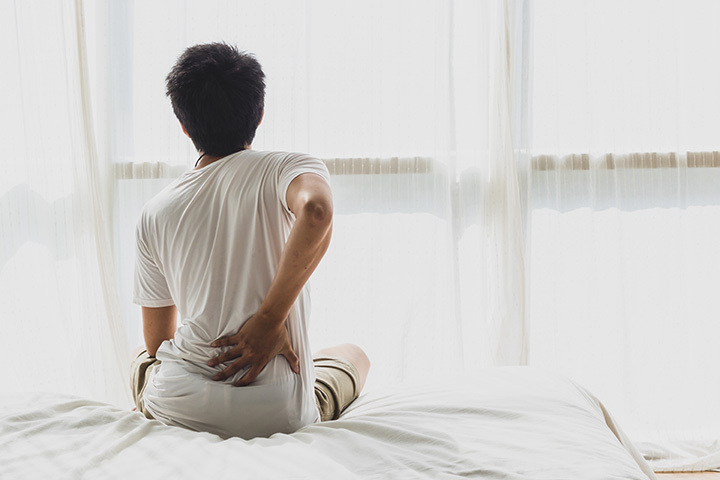周適偉(Shih-Wei Chou)
大專體育學刊 ; 23卷3期 (2021 / 09 / 30) , Pi - v
繁體中文;英文 DOI: 10.5297/ser.202109_23(3).0000
不對稱骨盆或是骨盆歪斜在一般人群中並不少見(Kurki, 2017)
(圖片來源 / Unsplash)
不對稱骨盆或是骨盆歪斜在一般人群中並不少見(Kurki, 2017),在接受腹部電腦斷層掃描的323名研究參與者中,83.0%的人發現有骨盆左右不對稱(Badii et al., 2003),其中172名(53.3%)右半骨盆較小(平均不對稱3.0 mm),另外95名(29.4%)則是左半骨盆較小(平均不對稱2.1 mm),右半骨盆較小比左側更常見,在半側骨盆較小的參與者中,有95%的人左右相差不到0.5 cm。骨盆不對稱對姿勢和動作的影響,特別是在坐姿下的研究發現,骨盆不對稱或原發性脊柱側彎會導致姿勢不對稱、體重分布不均和肌肉張力不平衡(Jung et al., 2015),骨盆微小的解剖異常,也與軀幹動作機制的改變有關,導致腰椎動作不對稱和腰痛(Al-Eisa, Egan, Deluzio, & Wassersug, 2006b);將骨盆不對稱和下背痛受試者,對軀幹運動學的影響進行研究,並比較坐姿和站姿之間的差異(Al-Eisa, Egan, Deluzio, & Wassersug, 2006a),在坐姿下,骨盆不對稱和軀幹動作改變之間存有關連性,而患有下背痛的人,可能是繼發骨盆不對稱的補償機制,使得腰椎承受更高的壓力,而引發下背痛。此外,根據上述研究(Badii et al., 2003),超過80%的普通人群有不對稱骨盆,其中95%左右側骨盆差異小於0.5cm,雖然是細微(<0.5cm)卻是常見(83%)的不對稱骨盆,坐在對稱椅面及面對衰弱老化的同時,使得頸背部疼痛成為不可避免的問題,或說是人類的宿命。
就體格(肌肉骨關節)的健康而言,要改變頸背疼痛的人類宿命?就應該先考慮結構性或功能性的骨盆不對稱,並提供解決方案,例如:加強核心訓練及改善座椅設計等等,作為不對稱骨盆的「對稱」解決方案。核心訓練,作為不對稱骨盆的「主動性對稱」解決方案,提供軀幹動態且對稱的穩定力量,進一步可以改善骨盆歪斜所引發的不對稱或代償性的姿勢或動作。脊柱的彎曲度與骨盆的不對稱有一致性的關係,並造成軀幹在姿勢或動作中,結構和功能的破壞(Gaggini, 2010);由於四肢和軀幹之間存在力學與控制的廣泛連結,而軀幹又根植於骨盆核心,因此,骨盆的任何不對稱都可能在執行姿勢或動作中,造成混亂的後果。核心穩定肌群,是一種持續性收縮的內在慢速肌群,可以維持人體的重心線穩定在核心組織上,並減少對時相性收縮的外在快速肌群的依賴;骨盆歪斜,造成身體左右受力不對稱,非核心肌群的外在快速肌群會代償性地收縮,藉以改善軀幹穩定性,因而被慢性過度使用,例如長期久坐,其原有時相性的快速收縮能力反而下降或喪失;因此,核心穩定肌群的訓練,可以避免姿勢或動作中可能出現的這種混亂(Moyer, 2019),同樣地,有原發性脊柱側彎的青少年,在為期8週的核心訓練後,不對稱性得到了改善(Kim, Ahn, & Jeon, 2020)。
座椅設計,可以提供不對稱骨盆另一項「被動性對稱」解決方案。下背痛常常是發生在久坐之後,在臨床上並不少見,長期久坐一直被視為下背痛的危險因子之一(Frymoyer et al., 1980)。骨盆不對稱導致體內力量的分布混亂,臀部與座椅間介面的臀底壓力的分布不均(Peterson & Adkins, 1982),長期不對稱的力量與壓力,伴隨出現肌肉骨關節的問題,主要是下背痛(Giles & Taylor, 1981),甚至是頸肩痛等問題,因此在坐姿下,臀底壓力分布受人體物理結構和生物力學的影響很大(Bar, 1991);然而,在人類座椅的設計中,卻都是基於對稱骨盆的假設,事實上,對稱骨盆只占不到20%的人,而不對稱占80%以上,就比例來說,不對稱骨盆可能才是正常;座椅舒適性的感知水準,和臀部與座椅間介面的壓力分布有關(Dinsdale, 1974; Staarink, 1995);15名正常受試者在坐姿下,臀底壓力分布顯示,總壓力是平均分布的,18%在個別坐骨結節,21%在個別大腿,5%在薦椎,其餘17%的平均分布在其他整個坐區(Drummond, Breed, & Narechania, 1985)。
為了平衡不對稱坐姿壓力及伴隨的不對稱脊柱力量,並藉以釋放核心負擔,座椅設計應在臀部座椅介面上提供平衡的壓力分布,無論骨盆對稱性如何,坐姿平衡對所有人都有好處,包括發育中的青少年或退化性的老年人、坐式生活或坐輪椅的人等等,都需要一張衡壓承載的座椅。
Asymmetrical pelvis or oblique pelvis is not uncommon in general population (Kurki, 2017).
Asymmetrical pelvis or oblique pelvis is not uncommon in general population (Kurki, 2017). About 83.0% participants, who received abdominal computed tomography (CT) scans reported to have pelvis bone asymmetry (Badii et al., 2003). Out of 323 participants, 172 (53.3%) had a smaller right hemipelvis (mean asymmetry = -3.0 mm), and 95 (29.4%) had a smaller left hemipelvis (mean asymmetry = 2.1 mm). A smaller right hemipelvis is more common than left. The difference between left and right was less than 0.5 cm in 95% of the participants with a smaller hemipelvis. The effects of pelvic asymmetry have been studied on posture and mobility especially during sitting. Pelvic asymmetry and idiopathic scoliosis cause postural asymmetry, unequal weight distribution, and muscular imbalance during sitting (Jung et al., 2015). Subtle anatomic abnormality in the pelvis is associated with altered mechanics in trunk movement, which then lead to asymmetry of lumbar movement and low back pain (LBP) (Al-Eisa, Egan, Deluzio, & Wassersug, 2006b). Effects of pelvic asymmetry and LBP on trunk kinematics were compared between sitting and standing (Al-Eisa, Egan, Deluzio, & Wassersug, 2006a). A link exists between pelvic asymmetry and altered trunk motion in sitting posture. People with LBP may have a distinct compensatory mechanism, secondary to pelvic asymmetry, which puts the lumbar spine under higher stress. According to the study by Badii et al. (2003), more than 80% of general population may have asymmetrical pelvis, and 95% of which displayed less than 0.5 cm differences between left and right hemipelvis. Subtle (< 0.5 cm) but "normal" asymmetry (83%) in pelvis, facing symmetrical seating devices and aging frailty, may act as a human fate of neck and back pain or problems.
In terms of the physical means for health, structural or functional pelvic asymmetries, such as a core training program or the seating design, should be considered. Core training provides torso symmetrical and dynamic stability for asymmetrical posture and motion associated with oblique pelvis. Spinal curvatures consistent with asymmetries in pelvis disorganized structural and functional consequences for the torso (Gaggini, 2010). With extensive connections between limbs and torso, which is rooted in the pelvic core, any asymmetry in pelvis may sequentially bring disorganized consequences in posture and motion. A core stabilizing muscle, which is intrinsic, slow-twitch and tonic in nature, could brings a person’s line of support into the core tissue, with less dependence on the extrinsic, fast-twitch, phasic muscles. The extrinsic muscles, other than core muscles, are inordinately used in oblique pelvis for stabilizing support, and subsequently decrease in their capacity for rapid, fast-twitch firing. Training of core stabilizing muscles may prevent from disorganization in posture and motion (Moyer, 2019). Likewise, asymmetry was improved with 8-week core training program for adolescent idiopathic scoliosis (Kim, Ahn, & Jeon, 2020).
The seating design may also provide symmetrical solutions for the asymmetrical pelvis other than core training. It is common experience that people with LBP suffer from more symptoms when seated. Prolong sitting has been regarded as a risk factor of the LBP (Frymoyer et al., 1980). Pelvic skeletal asymmetry leads to disorganized force distribution within the body and uneven sitting pressure distribution at the buttock-seat interface (Peterson & Adkins, 1982), subsequently developing musculoskeletal problems, mainly low back (Giles & Taylor, 1981) and even neck shoulder pain. Sitting pressure distribution was found to be highly influenced by the physical structure and biomechanics of the human body (Bar, 1991). However, the pelvis has been assumed to be symmetrical in the seating design. As a matter of fact, it is symmetrical only in less than 20% of people and not in more than 80% of the people. The perceived level of seating comfort is related to the sitting pressure distribution over the buttock-seat interface (Dinsdale, 1974; Staarink, 1995). The sitting pressure distribution in 15 normal subjects showed that 18% of the total pressure equally distributed over each ischial tuberosity, 21% over each thigh, 5% over the sacrum, and 17% remaining pressure distributed evenly throughout the sitting area (Drummond, Breed, & Narechania, 1985).
For the sake of seating balance and balanced spine to release core efforts, the seating design should provide even pressure distribution over the buttock-seat interface, regardless of pelvic symmetry. Seating balance benefits all, including developing adolescents or the degenerative elderly, the sedentary or the wheelchair-bound.
(本文節錄自:airitilibrary華藝線上圖書館https://www.airitilibrary.com/Publication/alDetailedMesh?DocID=15633470-202109-202110190005-202110190005-i-v)



